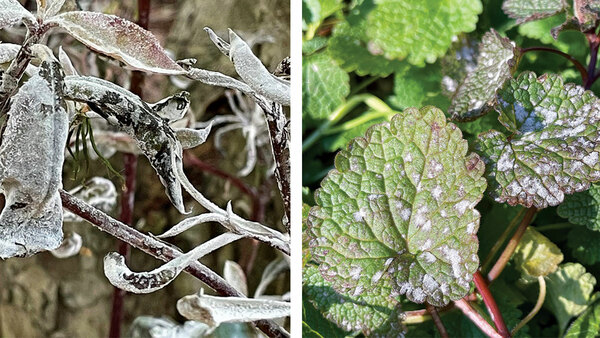
Powdery mildew can show up in a variety of plants in the Southeast, including trees, shrubs, perennials, and vegetables. The high humidity that we experience in the Southeast provides just the right conditions for this plant pathogen to grow. Powdery mildew is a fungus. It emerges as white or gray growth on stems, flowers, or leaves of diseased plants. More-severe infestations can result in shoots and leaves being twisted and distorted. Damage to flower buds often causes misshapen flowers that are of low quality. Powdery mildew may even prevent flowering on infected plants. Not every plant is highly susceptible to powdery mildew. However, if a plant is known to be infected easily, there are some steps you can take. Here are some highly susceptible plants.
Plants most susceptible to powdery mildew in the Southeast
Woody plants: Roses, crape myrtles, lilacs (Syringa spp. and cvs., Zones 3–8), euonymus (Euonymus spp. and cvs., Zones 3–9), dogwoods (Cornus spp. and cvs., Zones 3–9), some oaks (Quercus spp. and cvs., Zones 3–10), some hydrangeas (Hydrangea spp. and cvs., Zones 3–9)
Herbaceous plants: Verbena (Verbena spp. and cvs., Zones 3–11), phlox (Phlox spp. and cvs., Zones 3–8), bee balm (Monarda spp. and cvs., Zones 4–9), zinnias (Zinnia spp. and cvs., Zones 4–9), gerbera daisy (Gerbera jamesonii, Zones 8–10)
Vegetable crops: Cucurbit crops, including squash, cucumbers, pumpkins, and melons.
Preventing powdery mildew
Powdery mildew is a very common pathogen in the Southeast. It’s hard to escape its presence in your garden. However, there are a few things you can do to stop problems before they start. The majority of these involve cultural control methods. Perhaps the most important is choosing disease-resistant cultivars from the start. Modern plant breeding has brought us many varieties of garden favorites less susceptible to powdery mildew. For example, there are now many cultivars of crape myrtle (Lagerstroemia spp. and cvs., Zones 7–9), flowering dogwood (Cornus florida, Zones 5–8), and many cucurbit crops that show resistance to powdery mildew.
Factors that favor powdery mildew
Susceptible plants are infected via airborne spores. Infection is most likely to happen when temperatures are more moderate (65° to 90°F). Growth of the fungus is often inhibited when temperatures exceed 90°F. Mildew spores do not need free-flowing water to reproduce. Fungal growth is favored by cooler nighttime temperatures and high relative humidity.

Give susceptible plants some room
Another way you can help ward off powdery mildew in the Southeast is by spacing plants appropriately in the landscape. If a plant is known to be susceptible, you can help ward off a powdery mildew infection by not crowding susceptible plants. This is important with ornamentals, and I find it particularly critical for some vegetable crops. For example, cucurbits cannot easily be grown in tight spaces in the Southeast. Do everything you can to get these plants good airflow. This includes good spacing. Additionally, avoid planting all your cucurbits in the same areas of the garden as you did the previous year.
Use less fertilizer
Fertilizing too heavily can lead to the exacerbation of powdery mildew. Avoid using excess nitrogen fertilizer on plants known to be susceptible. This is especially important if young foliage has already become infected with mildew.

Treating a powdery mildew infection
Powdery mildew is caused by mildew fungi in several genera. Unlike most fungi, mildews only colonize the surface of plants. This means that eradication is possible. This can involve the judicious use of fungicides or wettable sulfur. Keeping leaves wet also helps prevent the spread of powdery mildew spores. Talk to an extension agent at a regional university in your area for more-specific information. Remember, control of powdery mildew starts with the plants you choose. Picking varieties that show known resistance to powdery mildew will always be your best bet.
For more on preventing and treating powdery mildew, check out:
—Andy Pulte is a faculty member in the plant sciences department at the University of Tennessee.


















Comments
Log in or create an account to post a comment.
Sign up Log in